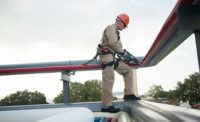Over the last several years, connected safety has changed the way companies keep their workers safe and their operations efficient. Connectivity has impacted and improved a number of safety processes from gas detection and lone worker monitoring to automatic compliance reporting.
While the safety industry is increasingly adopting connected technologies, our industry has traditionally lagged behind others such as consumer, retail and finance. Many safety professionals may still be unaware of how far reaching and impactful connectivity can be to overall worker safety. One of these areas is fall protection.
Connected technology has emerged over the last decade and can boost the level of safety for those who work at elevation, enhancing a fall protection equipment program. While fall protection PPE is an incredibly important and vital component of safety, it doesn’t account for every scenario and can leave workers vulnerable if an accident does occur.
This article examines the safety gaps left open by fall protection and how connected safety can help bridge those challenges for a comprehensive safety program that gives workers the confidence they need to get the job done. But first, let’s discuss what kind of workers need fall protection.
Who is working at heights?
While it is common that workers in the oil & gas, petrochemical and manufacturing fields work at heights, construction is one of the most dangerous fields when it comes to falling from elevation. In fact, falls are the leading cause of death in construction, with 320 fatal falls to a lower level representing a large fraction of the 1,008 construction fatalities in 2018, according to OSHA.
Further amplifying the risk of a fatal fall, many of these individuals are defined as lone workers, or personnel working in isolation — beyond the sight and sound of others. This presents a major safety risk that many companies are tackling through spot checks or radio calls. These inefficient forms of monitoring take up valuable time and are often ineffective at proactively detecting a fall in real time and initiating an immediate emergency response. That’s where connected safety comes in.
What is connected safety?
Before safety professionals can implement connected safety as part of their fall protection program, it is important to understand what the technology is and how the benefits can impact workers in the field.
At its core, connected safety can be defined as wearable technology that can unify several devices, including a lone worker monitor, gas detector and walkie-talkie into a single solution for a holistic approach to worker safety. Connected safety devices often incorporate 4G direct-to-cloud connectivity, enabling workers to benefit from remote monitoring while staying in constant communication with each other.Location technology provides supervisors or a live monitoring team with full situational awareness through wireless connectivity that streams data continuously to support a proactive emergency response at any moment.
Layering connected safety on top of fall protection PPE will ensure that workers in any situation are fully protected by addressing scenarios where fall protection equipment alone may leave workers at risk.
What happens when fall protection equipment fails?
Fall protection harnesses and arrest equipment is incredibly effective at, however, there are additional nuances where an employee hit an object or surface during the initial phase of a fall. Additionally, fall protection PPE can ease the fall action for an employee, but cannot help a worker who has suffered a health event that contributed to the fall. In these cases, it is critical to identify and respond to a worker proactively and with zero delay. The most efficient response time can mean the difference between a rescue versus more substantial negative outcomes, or worse.
Using traditional fall protection monitoring processes like spot checks or radio calls, a worker who has fallen may go undetected for tens of minutes to hours — whether he or she is conscious or unconscious. In this situation, workers who are equipped with a connected safety wearable device can alert supervisors or monitoring personnel instantly, triggering a response team to the worker’s location without delay.
For a worker who falls and remains conscious, he or she can notify emergency personnel using an SOS trigger or push-to-talk (PTT). An SOS trigger is typically available on connected safety wearables in the form of a button or fool-proof latch, which the worker can pull manually to trigger an emergency alert. PTT provides supports efficient collaboration like a walkie-talkie, operates without range limitations when within 4G coverage and doesn’t require radio licensing. For emergency situations like a fall, an SOS trigger and PTT serve as a lifeline.
What if a worker falls and is unconscious?
Every fall is different. For a worker who falls and becomes unconscious, innovative technology can automatically detect that an incident has taken place and send out an emergency alert to monitoring teams. Connected safety wearables that incorporate fall detection technology are able to detect sudden acceleration, indicating a fall and triggering emergency response. This technology is often customizable and can tailor to a worker’s specific scenario, minimizing false alarms.
In addition to fall detection technology, connected safety wearables may also incorporate a periodic check-in timer. In an unconscious worker scenario, this timer acts as a failsafe. If the worker doesn’t check-in via a button on the device, emergency personnel are notified immediately. These features, alongside location technology, allow monitoring teams to quicky determine the well-being of a worker and dispatch emergency personnel to the exact location if he or she needs help.
How do you address safety hot spots and work to prevent falls in the future?
Traditionally, the feedback loop for identifying safety hot spots, implementing corrective safeguards and measuring improvement is lengthy and often disjointed, requiring input from several teams working in silos. With cloud-connected safety wearables, data from each device is streamed to the cloud for safety professionals to access, analyze and use to develop a fact-based, unified path to addressing safety concerns.
Leveraging this data to gain valuable insights into the worksite takes the guesswork out of addressing where safety incidents occur most. It allows you to better visualize a situation, identify a problem and develop a well-informed solution. In addition to tackling safety concerns in real-time, these insights from data enable safety professionals to practice preventative safety to mitigate against future incidents, achieve safety objectives and eliminate worksite safety hazards.
As companies continue to undergo digital transformation, the concept of connectivity is increasingly being adopted to enhance safety and productivity for workers in hazardous or harsh environments. Connected safety doesn’t replace but rather supplements current physical worksite safety procedures to streamline and strengthen safety processes. PPE, especially fall protection gear, will always be the first line of defense. However, companies who take a connected approach to their operations benefit from real-time situational awareness that empowers them to be more proactive in the event of an incident, to ensure their workers make it home safe at the end of each day.



